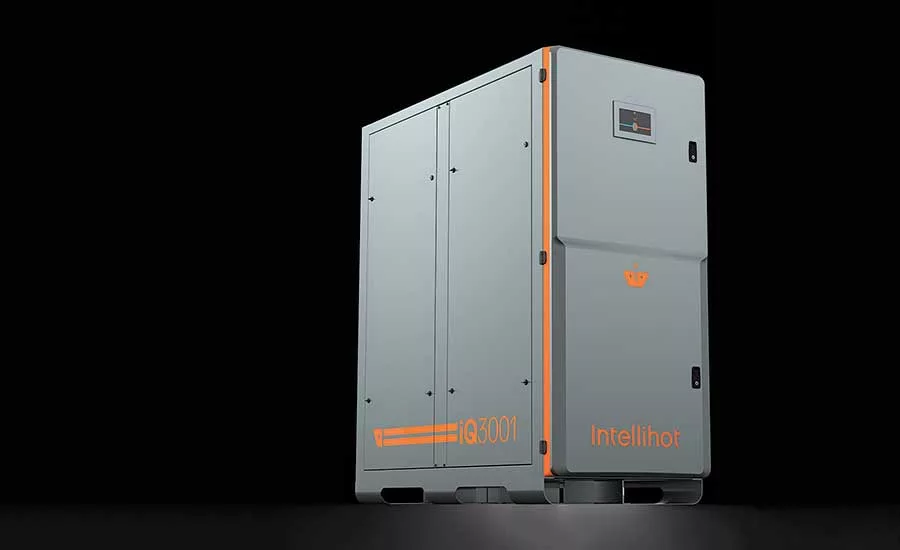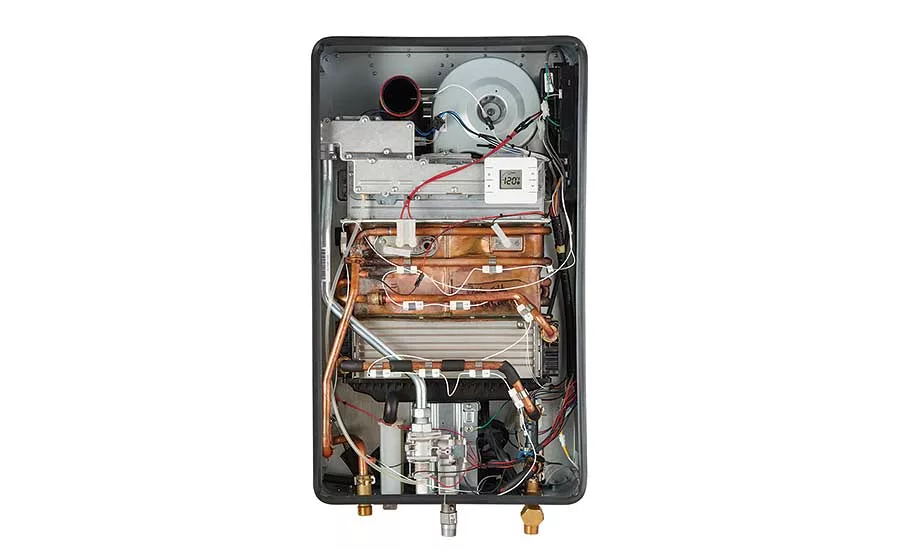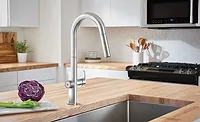Top water heating trends of 2018

Intellihot iQ3001 commercial high-output, on-demand water heater.

Bosch Greentherm 9000 tankless water heater

Rinnai Sensei Tankless Water Heater.
While new energy efficiency standards shook up the water heating industry in 2015, these products are still undergoing many changes as a number of factors continue to shape storage-type and tankless water heater design. Additionally, the Internet of Things is helping give installers and end users new and unique insight into — and control over — their equipment.
Top residential trends
On the residential side, the top trends are efficiency, ease of installation, smart-home integration, water conservation, and affordability.
Efficiency. “The focus on sustainability is backed by NAECA energy efficiency regulations and the HERS index, which measures a home’s overall footprint,” says Eric Manzano, product training supervisor, Noritz. “Market competition with other manufacturers striving for the same energy efficiency goals encourages further breakthroughs in designing improved technologies. The global community is pushing for lower net energy usage through participation in the Paris Accord Agreement. This international regulation, along with local and state mandates, pushes innovation in our industry to constantly make products more efficient, durable, and green.”
Ease of installation. “Ease of installation is top of mind for many contractors and contracting business owners,” says Jeff Ogan, A. O. Smith’s director of water heater product management and technical support. “As water heating has evolved over the years, installers have had to evolve, too. This means learning new technology and product benefits as well as new installation best practices and proper maintenance. Contractors want to provide great customer service, and manufacturers are responsible for developing products to help them deliver that level of service.”
Smart-home integration. “The latest water heating innovations include better technology to make water heaters more intelligent than ever before,” says Scott Cohen, senior manager, marketing and training, Rheem Water Heating. “For instance, Rheem launched the Prestige Series Hybrid Electric Water Heater features the exclusive EcoNet built-in leak detection system. This system sends a notification straight to a smartphone if a leak is detected and sets off an alarm at the water heater.”
Water conservation. “Recirculation systems are one of the major influences on residential water heater design,” says Freddie Molina, water heaters product manager, Bosch Thermotechnology Corp. “Due to water scarcity, building codes no longer allow water to be wasted. This includes turning on water and waiting for it to heat up. Recirculation systems allow the homeowner to receive hot water instantly by circulating water with assistance of a pump through the water line back to the heat source.”
Affordability. “Nobody wants to pay more than they have to,” Intellihot CEO Sri Deivasigamani says. “Consumers are looking for products that not only save upfront but continue to provide value over the product’s lifetime.”
Interestingly, homeowners are driving many of these trends, and they are better educated than ever before.
“Overall, we are seeing a much savvier consumer base,” Cohen says. “Homeowners are educating themselves thanks to the internet and increased access to information regarding water heater performance features and options. Now more than ever, consumers understand and appreciate the benefits of installing highly efficient water heating systems.”
Top commercial trends
On the commercial side of water heating, the trends are similar, with efficiency continuing to be a driver of product design for tank-type and tankless systems. Commercial trends include:
Efficiency. “Customer need for efficiency and dependability, and then a variety of state and national regulations, greatly influence design,” says Carl Pinto, director of marketing for Bradford White. “Customer demand, given the pressure for commercial facilities to utilize more efficient and more cost-effective products for their water heating and storage needs, is one driver. Regulatory requirements are another. For example, in March 2017, Utah signed House Bill 37 into law. This bill amends provisions related to the state construction code for many items, including limiting emissions of natural gas-fired water heaters. These emission level limits are consistent with what was introduced in multiple Air Quality Management Districts [AQMD] in California over the past decade.”
Ease of installation. “We see a trend in the commercial market going towards redundancy and easy, quick installations,” says Eric Ashley, product development manager, Navien. “Commercial trends are driven by specification or facility owner/operator requests.”
Affordability. “The second driver is that owners/end users want lower acquisition, operation and life-cycle costs,” says Dale Schmitz, marketing manager — commercial segment for Rinnai. “That has really been the case for a number of years but now they realize it is attainable without sacrificing the quality or availability of the products or services they require.”
Connectivity. “App-based connectivity that now allows for remote monitoring from connected commercial water heaters,” says Matt Schulz, senior product manager for commercial products at A. O. Smith. “As IoT technology has become mainstream, commercial facility managers have naturally started looking for commercial water heaters to offer connectivity and mobile access.”
Common venting. “The ability to common vent water heaters and incorporate redundancy of operation into the system, along with increased interest in products that help achieve LEED certification, are major trends impacting our industry’s commercial market,” Manzano says.
Contractor influence
Even though many trends are driven by regulations or consumer demand, manufacturers are still working hard to keep systems installers in mind when designing new products.
“When designing commercial products, we gather information and feedback from the commercial end-users,” says Richard Ponce, national sales manager, Vesta. “We do value their feedback, and what installers want most is ease of installation and product support from the manufacturer.”
“At A. O. Smith, our engineers and developers routinely evaluate product design and try to incorporate insights and experience from installers,” says Ralph Perez, senior manager for sustaining products at A. O. Smith. “We do this because we want our water heating products to be easy to handle, install and maintain. A. O. Smith includes facility managers and commercial contractors early on in the design phase of new products, which helps us ensure our future products are aligned with what the marketplace needs.”
Jennifer Kaminski, residential tankless category director, Rinnai, says they work to ensure ease of installation for contractors.
“Flexible venting options reduce time and cost of installation, and we keep ergonomics — size, weight and easy mounting — in mind for the installer when designing our products,” she says. “We enable the installer to easily service the unit after installation with accessibility and clear instructional guides.”
“We aim for ease of installation,” says Ernie Wilson, applications engineer, renewable sales Stiebel Eltron USA. “We do this by manufacturing high-quality, reliable products that both reduce customer call-backs and prove to customers the expertise of their installer, and by creating installation documentation that is as clear and unambiguous as possible.”
What’s next for water heating
The biggest single trend shaping water heating products is technology — specifically connectivity and the ability to remotely monitor equipment.
“The opportunity connectivity brings to contractors is a game changer,” A. O. Smith’s Perez says. “As water heating connectivity evolves further, contractors may soon have the opportunity to stay connected remotely to every product they install and offer value-added services when water heaters are due for maintenance.”
“Plumbers should expect connectivity to have a growing presence for both residential and commercial water heaters,” Bradford White’s Pinto says. “Some of that connectivity will be designed to enhance the user experience as well as increase a contractor’s ability to support and service their residential and commercial customers’ water heating products.”
Manufacturers say the best way to stay on top of emerging trends in water heaters and other equipment is to attend training as often as possible.
“There is so much training available today, I would say taking advantage of what is offered by manufacturers, industry groups and trade organizations is the best way to stay fresh and nimble in a rapidly changing industry,” Schmitz says. “Rinnai’s live training events, e-learning courses and webinars are a great resource to tens of thousands of plumbing professionals each year in our quest to keep them on top of the latest product and industry information.”
“Due to the increasing prevalence of heat pump water heaters, they need to understand how these devices work so that they observe the air clearance and room size specifications,” Stiebel Eltron’s Wilson says. “In many states, continuing education is required in order to keep your plumbing license.”
Noritz’s Manzano says trade shows are also a great way to see and even experiment with the many different emerging technologies.
“These shows are generally how manufacturers showcase their new products and trends in the industry," Manzano says. "The local PHCC is another great resource for the latest in the plumbing industry.”
Looking for a reprint of this article?
From high-res PDFs to custom plaques, order your copy today!








